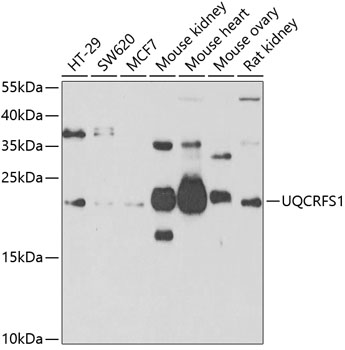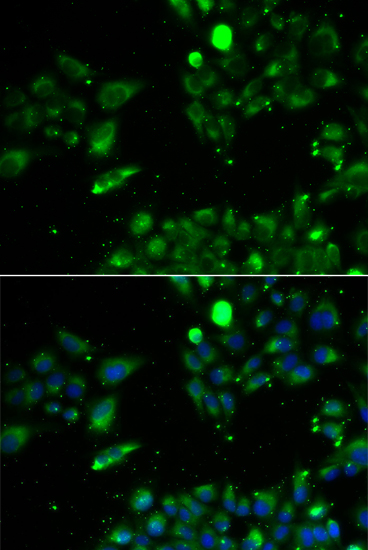-
Product Name
UQCRFS1 Polyclonal Antibody
- Documents
-
Description
Polyclonal antibody to UQCRFS1
-
Tested applications
WB, IF
-
Species reactivity
Human, Mouse, Rat
-
Alternative names
UQCRFS1 antibody; RIP1 antibody; RIS1 antibody; RISP antibody; UQCR5 antibody; cytochrome b-c1 complex subunit Rieske, mitochondrial antibody
-
Isotype
Rabbit IgG
-
Preparation
Antigen: Recombinant fusion protein containing a sequence corresponding to amino acids 79-274 of human UQCRFS1 (NP_005994.2).
-
Clonality
Polyclonal
-
Formulation
PBS with 0.02% sodium azide, 50% glycerol, pH7.3.
-
Storage instructions
Store at -20℃. Avoid freeze / thaw cycles.
-
Applications
WB 1:500 - 1:2000
IF 1:10 - 1:100 -
Validations

Western blot - UQCRFS1 Polyclonal Antibody
Western blot analysis of extracts of various cell lines, using UQCRFS1 antibody at 1:1000 dilution.Secondary antibody: HRP Goat Anti-Rabbit IgG (H+L) at 1:10000 dilution.Lysates/proteins: 25ug per lane.Blocking buffer: 3% nonfat dry milk in TBST.Detection: ECL Basic Kit .Exposure time: 90s.

Immunofluorescence - UQCRFS1 Polyclonal Antibody
Immunofluorescence analysis of U2OS cells using UQCRFS1 antibody . Blue: DAPI for nuclear staining.
-
Background
Cytochrome b-c1 complex subunit Rieske, mitochondrial: Component of the mitochondrial ubiquinol-cytochrome c reductase complex dimer (complex III dimer), which is a respiratory chain that generates an electrochemical potential coupled to ATP synthesis. Incorporation of UQCRFS1 is the penultimate step in complex III assembly.; Cytochrome b-c1 complex subunit 9: Possible component of the mitochondrial ubiquinol-cytochrome c reductase complex dimer (complex III dimer), which is a respiratory chain that generates an electrochemical potential coupled to ATP synthesis. UQCRFS1 undergoes proteolytic processing once it is incorporated in the complex III dimer, including this fragment, called subunit 9, which corresponds to the transit peptide. The proteolytic processing is necessary for the correct insertion of UQCRFS1 in the complex III dimer, but the persistence of UQCRFS1-derived fragments may prevent newly imported UQCRFS1 to be processed and assembled into complex III and is detrimental for the complex III structure and function. It is therefore unsure whether the UQCRFS1 fragments, including this fragment, are structural subunits.
Related Products / Services
Please note: All products are "FOR RESEARCH USE ONLY AND ARE NOT INTENDED FOR DIAGNOSTIC OR THERAPEUTIC USE"
